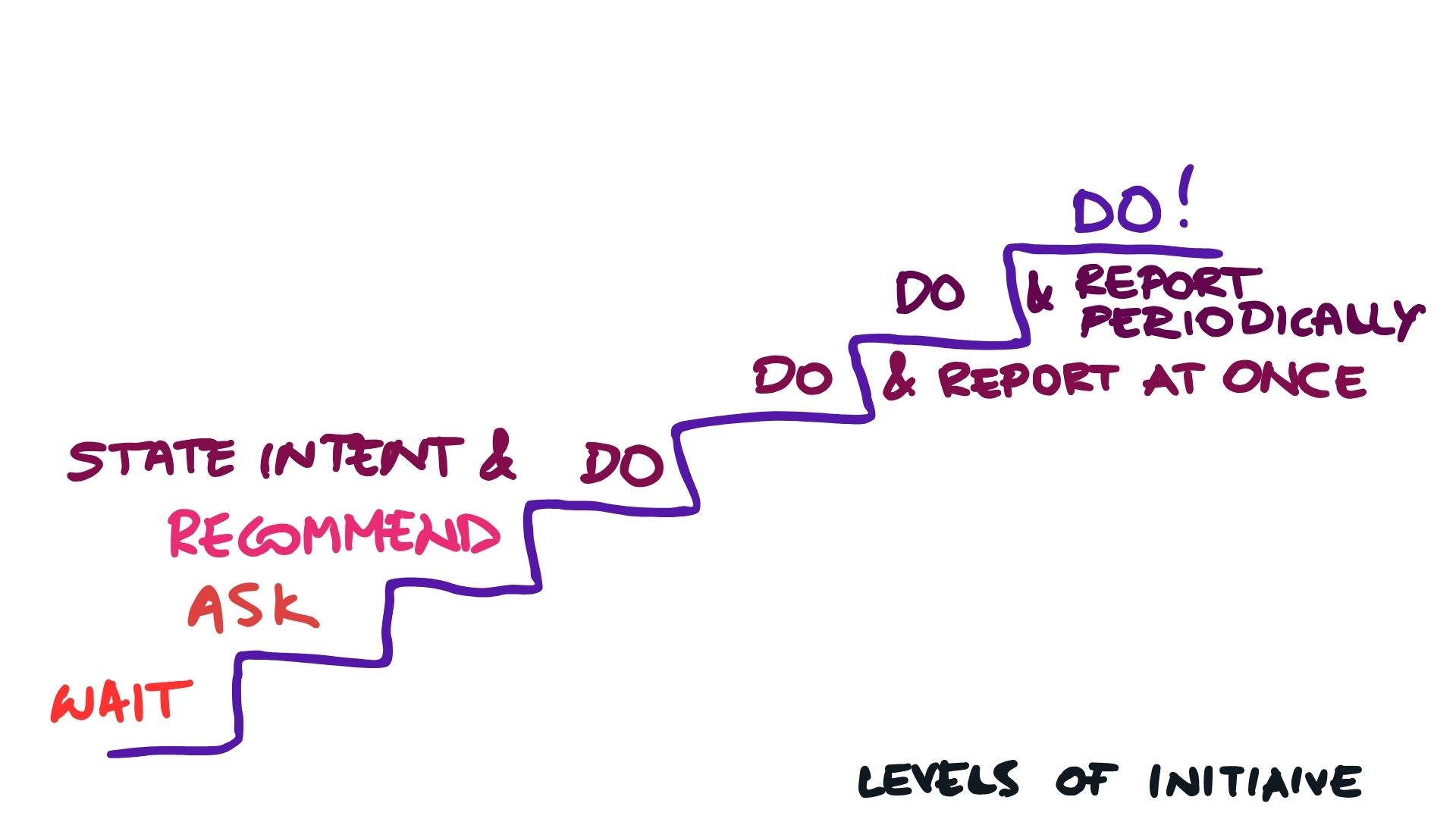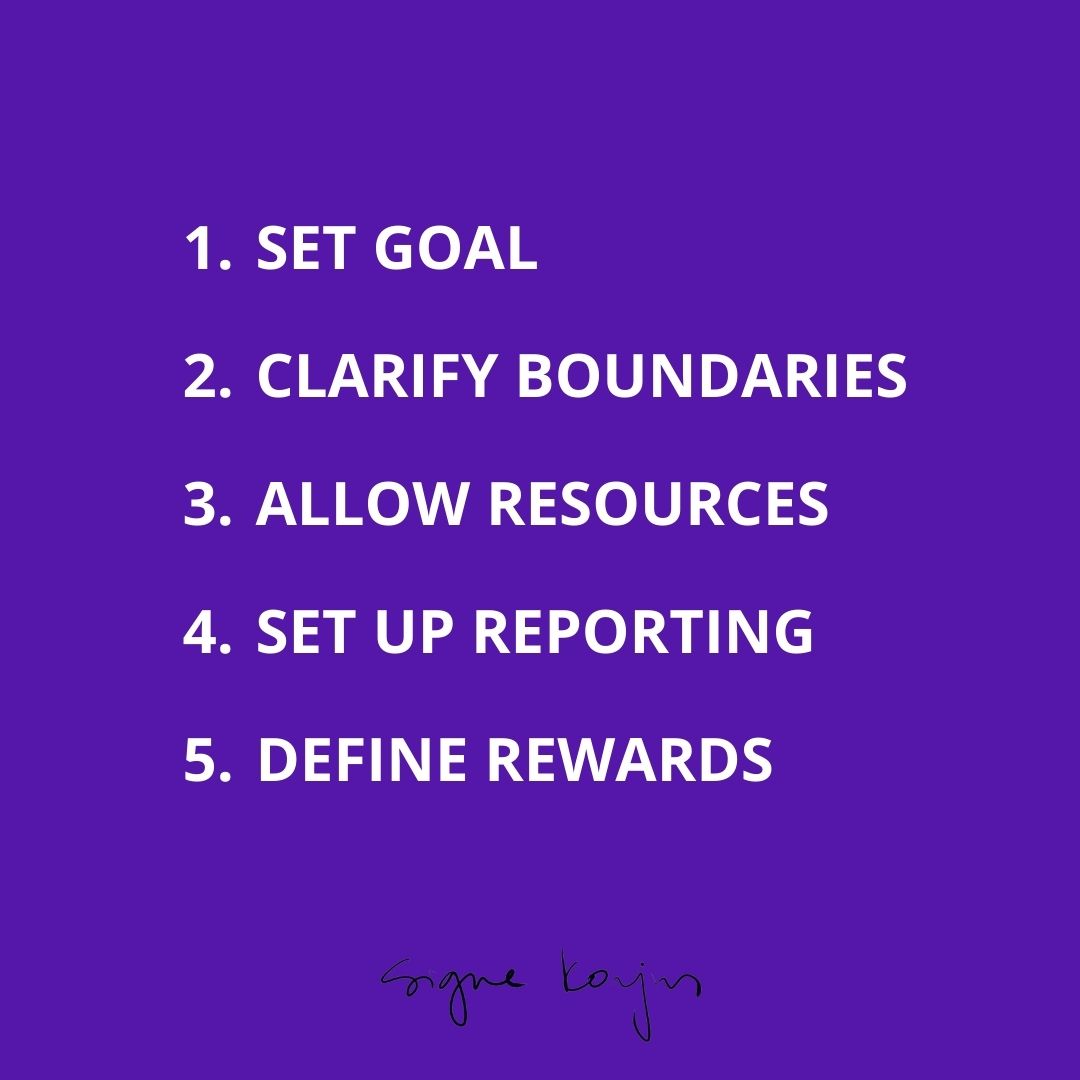“I just want my people to think for themselves, have and show initiative, think two steps ahead and anticipate problems before they arise. But instead, I find them passively waiting for orders and doing the minimum. Why aren’t they more self-directing?”
If you have ever felt this way as a leader, read on, because I have something for you.
The answer revolves around developing initiative, but let me build it up for you, so you will also be able to implement the solution.
As a leader you make an effort to hire the right people for your team. You consider, what is important to you and very likely prefer character over skill or experience, because you’ve heard the advice ‘to hire for attitude and train for skill’. You probably look for proactivity, integrity, accountability – things we like to see in everyone we work with. But when these right people with the right attitude come on board, it is as if they suddenly lose everything they seemed to have during the recruitment process. You may even start doubting your selection and decision-making skills.
It does not hurt to review and refine your recruitment skills either, however, often the problem is not in selection, but how you build up your cooperation. Building a relationship of accountability is part of onboarding, and training for initiative is key to independence in team.
Initiative just like confidence is contextual and related to both skills and relationships. Even if the person you hired demonstrated proactivity during the interviews, they may need some support in building their initiative up in your organisation.
What does it even mean to build initiative? Isn’t initiative a yes-or-no thing, i.e. you either have it or not? Well, not exactly. When someone seems to lack initiative, it does not mean, they have none of it, but their degree of initiative is not sufficient in the context. Stephen R. Covey introduced seven levels of initiative in his book The 8th Habit. These levels are:
- Wait until told
- Ask what to do
- Make a recommendation
- Inform of your intent and act
- Act and report immediately
- Act and report periodically
- Act
Waiting to be told what to do is clearly the lowest level of initiative. Leaders usually like this level the least. But before condemning anyone for inaction you must understand the reasons behind it. The highest level of initiative is about full autonomy and ownership. Let’s first take a closer look at these levels and then how to help your people increase their initiative.
Levels of initiative
Initiative is related to not only interest, but also to confidence and competence. If any one of these is low, your initiative is blocked.
If you have little interest for something, you are not likely to show initiative. If you don’t feel confident doing something or lack faith in yourself, you are less likely take a step. If you don’t know how to do something, you will likely delay action.
You may also have limiting beliefs and experiences. If you have ever tried something new and were judged for acting upon your curiosity or the result of your action has been criticised, you may have developed a belief that it’s safer to not start or do anything.

Moving up the levels of initiative can also be described as the journey from novice to master. You start on a lower level, and as you develop your confidence and competence, you move up towards more autonomy and ownership.
- So, on the first level of initiative you wait until you’re told what to do and how to do it. Someone telling you is the driving force of action. You act only in the limits of what and how you are told. Not only does this level represent lack of initiative, but also lack of responsibility, because if something goes wrong, you are likely to blame the one who gave you the task and instructions.
- The second level shows interest for action. While on the first level your team member may aimlessly scroll their phone until new task is given; on the second level they come and ask if there is something they can do.
- On the third level they already come to you with a suggestion. They have noticed something that could or should be done and ask if they could do this.
- The fourth level is a step ahead and there you inform that you are going to do something and go do it, without waiting for permission.
- The fifth level skips the informing part, and takes action. After you have done what you decided to do, you immediately report to your leader what you have done and what was the outcome.
- The sixth level also means you take action without specific permission, and report only periodically. For example, during your weekly, fortnightly or monthly one-to-one.
- The seventh level describes fully independent action, where no permission is asked for or given and no reporting takes place. This level of initiative describes top executives for example, whose responsibility is to take action and ensure others take relevant action. Of course, since we live in an interdependent world and organisations are highly interdependent, executives may and should share at least some of their work with their team and organisation to create transparency and alignment, but they do not report to someone for taking action.
How to develop initiative?
Depending on the role, as a leader you probably want your team members to be on levels 3–6. From younger and less experienced team members you expect at least recommendation. You want them to notice what is going on in their role, their environment, and you want them to think of possible solutions, of how to add value.
From more experienced team members you may expect periodical reporting after you have agreed on periodical goals and general action plans. But what to do when your expected level of initiative is simply not met? If your people just sit and wait for you to give the next task or order?
You can help your team members build initiative in four simple steps.
- Step 1: CLARIFY GOALS AND EXPECTATIONS
- Step 2: GET GOING
- Step 3: REMOVE OBSTACLES
- Step 4: STICK TO YOUR AGREEMENT
Step 1: CLARIFY GOALS AND EXPECTATIONS
Development of initiative starts with clarifying expectations. This means you need to first clarify the desired results, i.e. the goal. Take your preferred goal setting framework (BHAG, SMART, OKR, KPI etc.) and define the desired outcome. Also remember the golden rule of communication: check for understanding, do not rely on merely on you articulating the goal.
In addition to the goal itself, you also need to clarify what kind of initiative you expect from your team member, what kind of actions are expectedly fruitful, which ones should be refrained from, what is the standard the outcome needs to meet, what are the rules that need to be followed, and where there is freedom to choose your course of action. For less experienced team members you may need to demonstrate or list as many possibly resultative courses of action as possible, for more experienced team members you only need to state what is an absolute no-go.

One obstacle that keeps people from taking initiative is lack of resources. They may start doing something, but discover shortly that they don’t have access to a database, or the task feels overwhelming and they lack capacity (time, energy, team). Make sure to clarify what resources are available and if more are needed, where to get them. One resource leaders often forget to make available is their own time and know-how. In developing initiative, it is vital, that you let your team members explicitly know that they can turn to you for support, help, knowledge, ideas etc. Many will feel trapped in their lack of know-how, as they feel uncomfortable asking for the leader’s time and energy, unless the leader has made herself available to them. As a leader, make sure not to do the same mistake.
Another part of clarifying expectations is setting up the cadence of reporting. This is preparation for developing onto sixth level of initiative. You may start off with more frequent reporting sessions, and adjust the interval as you go. Also agree what is reported on. Never skip a reporting session when you are teaching your team members initiative. If everything is clear, you can keep the session concise and short, but never skip it. This will undermine your credibility and their sense of relevance. If your team member’s progress is not of your interest and priority, why should they bother to stretch more?
Last but not least it helps if you clarify what happens next. What can they expect when they complete the task or project successfully? When they develop a higher level of initiative? What rewards can they reap? People are naturally drawn towards more autonomy and relatedness and better competence. Lean in to these natural pursuits and explain, how will the achievement of the set goals support them in any of these areas.
Step 2: GET GOING
This step is optional, although strongly recommended. It is related you the coach role of a leader. To increase the chances for success even more you may want to step into the shoes of a coach for a few moments.
First you can go through potential obstacles with your team members. A simple question “What could prevent you from fulfilling this agreement?” leads your team member to reflect upon if they have everything they need to get going. If they do come up with a potential roadblock, do what you can to remove it effectively. If you are unable to remove an obstacle, you cannot expect your team member to be able to do that. Remember, they are there to learn more initiative, not to teach you, how to overcome obstacles as a leader. You will then need to adjust the agreement. Reassure that you look after them and help them succeed.
“What could prevent you from fulfilling this agreement?”
If they don’t come up with any potential obstacles, continue with another simple question “What is your first step?” Since you are in this space of trust and cooperation already, that short question will help them set to action. If they leave this space without having defined the first step, they may lose the momentum and get stuck in trying to figure it out. Then other, more familiar tasks and inquiries come in and the one that requires more initiative will remain unattended.
Step 3: REMOVE OBSTACLES

After clarifying expectations and setting up the reporting rhythm, let your team member start taking action. Don’t be surprised if they still postpone the first step. It is not easy to level up your initiative. Remember, their current level of initiative is related to their past experiences and beliefs. There may be a whole lot of restructuring needed in their head and heart, before they are ready to take a step. Even if you are a go-doer yourself, respect that it may not be as easy for everyone else.
Step three focuses on removing obstacles. If they have not taken a step by your first reporting session, be ready and willing to put on a coaching hat. Before you jump to the issue, take a step back and create safety. Your team member will feel bad about not having delivered, but the smaller they feel, the less likely they are to take initiative. You need to put them at ease about missing the first cycle – it is good if it is rather small, one week at maximum. Emphasise that it is a learning process in addition to goal attainment, and that you are here to support their success. When they feel safe, you can ask some powerful coaching questions. Start with a simple “So, what’s been going on this last week (or whichever period it was since you making the agreement)?” Let them speak. Be genuinely curious and interested in their success.
If they tell you about an obstacle they met, you can address it. If it’s about a stress-response they experienced of having to level up their initiative, continue with recreating clarity about the agreement. Let them reiterate the agreement and continue to explore the obstacles they’ve experienced or expect to experience if they take a move. Remove any blockages and if needed adjust the agreement. Help them break the goal down to feasible first steps. Decrease the reporting interval even more, so that they can report to you even after each step they’ve taken. You will need to continue going back and forth with step three, until they make the first steps.
Step 4: STICK TO YOUR AGREEMENT
Once you have got the team member moving, stick to your agreement. Only this way you can keep them accountable. Stick to the reporting cycle. Never miss a session. If you feel the team member has built enough confidence and competence, you can adjust the reporting interval. Stay alert to changes in their sense of safety, and make further adjustments as necessary.
Depending on the scope or the length of the project or goal, you can evaluate progress in nurturing more initiative after a single project or several. Be sure to celebrate both their success and yours, because you have also grown as a leader. I love the saying that a leader cannot be more successful than his team. So, if you’re team members are successful, you are too.
I hope I have created more clarity around this seemingly amorphous subject of initiative. If you do take on the opportunity to help your people raise their level of initiative, you will be rewarded with people who think for themselves, have and show initiative, think two steps ahead and anticipate problems before the arise. You’ll build a team one member at a time, who will not only achieve the desired results and build your business, but who also appreciate your leadership.
#initiative #leaderascoach #greatleadership #buildinitiative